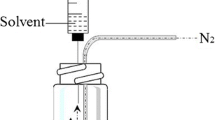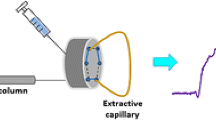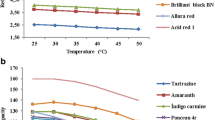Abstract
A rapid in situ analytical method was developed for the detection of generated carcinogenic aromatic amines from banned azo dyes utilizing a photocatalytic reduction-based liquid microjunction surface sampling (LMJSS)–mass spectrometry (MS) system. We utilized photocatalytic reduction under UV irradiation with TiO2 as catalyst to have rapid and mild reduction of azo dyes. The reaction conditions were optimized to have complete photocatalytic reduction within 2–5 min in pure methanol at room temperature. TiO2 was immobilized in the inner wall of the capillaries in the LMJSS system to achieve in situ sampling–online rapid reduction–MS detection for aromatic amines originating from azo dyes in packaging surface. The yields of in-tube photocatalytic reduction were near 100% by delivering the azo dye extracts through the capillary at 1 μL/min under UV irradiation. With this design, in situ analysis was completed within 2 min via direct MS detection and 7 min via liquid chromatography (LC)–MS detection. The detection limits for five aromatic amines originating from four different azo dyes were in the range of 1–17 mg/kg with relative standard deviations (RSDs) < 8.5%. In the application of the new method, four carcinogenic aromatic amines were detected and identified in three commercial packaging materials, and the quantitation results were comparable with those obtained by the conventional chemical reduction–LC–MS method (relative recovery, 81–121%). Moreover, due to the spatial resolution of the present method with a flow probe, MS imaging was achieved demonstrating clear azo dye patterns of a lab-made sample.
Graphical abstract






Similar content being viewed by others
References
Yang S, Han J, Huan Y, Cui Y, Zhang X, Chen H, et al. Desorption electrospray ionization tandem mass spectrometry for detection of 24 carcinogenic aromatic amines in textiles. Anal Chem. 2009;81(15):6070–9.
Cody RB. Observation of molecular ions and analysis of nonpolar compounds with the direct analysis in real time ion source. Anal Chem. 2009;81(3):1101–7.
Cheng C-Y, Yuan C-H, Cheng S-C, Huang M-Z, Chang H-C, Cheng T-L, et al. Electrospray-assisted laser desorption/ionization mass spectrometry for continuously monitoring the states of ongoing chemical reactions in organic or aqueous solution under ambient conditions. Anal Chem. 2008;80(20):7699–705.
Mei Y, Wu Q, Zhou SW, Wang ZG, Liang QJ, Li YM, et al. Rapid in situ quantitation of photoinitiators in packaging by two-points kinetic calibration of liquid microjunction surface sampling-mass spectrometry. Talanta. 2020;216:121017.
Van Berkel GJ, Kertesz V, Koeplinger KA, Vavrek M, Kong ANT. Liquid microjunction surface sampling probe electrospray mass spectrometry for detection of drugs and metabolites in thin tissue sections. J Mass Spectrom. 2008;43(4):500–8.
Wu Q, Huang ZH, Wang Y, Zhang ZM, Lu HM. Absolute quantitative imaging of sphingolipids in brain tissue by exhaustive liquid microjunction surface sampling-liquid chromatography-mass spectrometry. J Chromatogr A. 1609;2020:460436.
Martin NJ, Griffiths RL, Edwards RL, Cooper HJ. Native liquid extraction surface analysis mass spectrometry: analysis of noncovalent protein complexes directly from dried substrates. J Am Soc Mass Spectrom. 2015;26(8):1320–7.
Kaftan F, Kofronova O, Benada O, Lemr K, Havlicek V, Cvacka J, et al. Scanning electron microscopic imaging of surface effects in desorption and nano-desorption electrospray ionization. J Mass Spectrom. 2011;46(3):256–61.
Ranc V, Havlicek V, Bednar P, Lemr K. Nano-desorption electrospray and kinetic method in chiral analysis of drugs in whole human blood samples. Eur J Mass Spectrom. 2008;14(6):411–7.
Laskin J, Eckert PA, Roach PJ, Heath BS, Nizkorodov SA, Laskin A. Chemical analysis of complex organic mixtures using reactive Nanospray desorption electrospray ionization mass spectrometry. Anal Chem. 2012;84(16):7179–87.
Rao W, Pan N, Tian X, Yang Z. High-resolution ambient MS imaging of negative ions in positive ion mode: using Dicationic reagents with the single-probe. J Am Soc Mass Spectrom. 2016;27(1):124–34.
Vinodgopal K, Bedja I, Hotchandani S, Kamat PV. A photocatalytic approach for the reductive Decolorization of textile azo dyes in colloidal semiconductor suspensions. Langmuir. 1994;10(6):1767–71.
Platzek T, Lang C, Grohmann G, Gi US, Baltes W. Formation of a carcinogenic aromatic amine from an azo dye by human skin bacteria in vitro. Hum Exp Toxicol. 1999;18(9):552–9.
Hatch KL, Maibach HI. Textile dye allergic contact dermatitis prevalence. Contact Dermatitis. 2000;42(4):187–95.
Directive 2001/C96E/18. Official Journal of the European Union2001.
Ahlstrom LH, Eskilsson CS, Bjorklund E. Determination of banned azo dyes in consumer goods. Trends Anal Chem. 2005;24(1):49–56.
Iammarino M, Mentana A, Centonze D, Palermo C, Mangiacotti M, Chiaravalle AE. Simultaneous determination of twelve dyes in meat products: development and validation of an analytical method based on HPLC-UV-diode array detection. Food Chem. 2019;285:1–9.
Yu C, Liu Q, Lan L, Hu B. Comparison of dual solvent-stir bars microextraction and U-shaped hollow fiber-liquid phase microextraction for the analysis of Sudan dyes in food samples by high-performance liquid chromatography-ultraviolet/mass spectrometry. J Chromatogr A. 2008;1188(2):124–31.
Voyksner RD, Straub R, Keever JT. Determination of aromatic amines originating from azo dyes by chemical reduction combined with liquid chromatography/mass spectrometry. Environ Sci Technol. 1993;27:1665–72.
Straub RF, Voyksner RD, Keever JT. Determination of aromatic amines originating from azo dyes by hydrogen-palladium reduction combined with gas chromatography/mass spectrometry. Anal Chem. 1993;65:2131–6.
Arroyo Negrete MA, Wrobel K, Yanez Barrientos E, Corrales Escobosa AR, Acevedo Aguilar FJ, Wrobel K. Determination of sulfonated azo dyes in chili powders by MALDI-TOF MS. Anal Bioanal Chem. 2019;411(22):5833–43.
Ye X, Peng Y, Niu Z, Luo X, Zhang L. Novel approach for the rapid screening of banned aromatic amines in dyed textiles using a chromogenic method. Anal Bioanal Chem. 2018;410(11):2701–10.
Zhang Q, Wang C, Bai H, Wang X, Wu T, Ma Q. Determination of aromatic amines from azo dyes reduction by liquid-phase sorbent trapping and thermal desorption-gas chromatography-mass spectrometry. J Sep Sci. 2009;32(14):2434–41.
Akpan UG, Hameed BH. Parameters affecting the photocatalytic degradation of dyes using TiO2-based photocatalysts: a review. J Hazard Mater. 2009;170(2-3):520–9.
Hoffmann MR, Martin ST, Choi W, Bahnemann DW. Environmental applications of semiconductor Photocatalysis. Chem Rev. 1995;95(1):69–96.
Hao H, Zhang L, Wang W, Zeng S. Modification of heterogeneous photocatalysts for selective organic synthesis. Catal Sci Technol. 2018;8(5):1229–50.
Schneider J, Matsuoka M, Takeuchi M, Zhang J, Horiuchi Y, Anpo M, et al. Understanding TiO2 Photocatalysis: mechanisms and materials. Chem Rev. 2014;114(19):9919–86.
Daghrir R, Drogui P, Robert D. Modified TiO2 for environmental photocatalytic applications: a review. Ind Eng Chem Res. 2013;52(10):3581–99.
Joycepruden C, Pross JK, Li YZ. Photoinduced reduction of aldehydes on titanium-dioxide. J Organomet Chem. 1992;57(19):5087–91.
Park JW, Hong MJ, Park KK. Photochemical reduction of 1,2-diketones in the presence of TiO2. Bull Kor Chem Soc. 2001;22(11):1213–6.
He L, Wang JQ, Gong Y, Liu YM, Cao Y, He HY, et al. Titania-supported iridium subnanoclusters as an efficient heterogeneous catalyst for direct synthesis of Quinolines from Nitroarenes and aliphatic alcohols. Angew Chem Int Ed. 2011;50(43):10216–20.
Lachheb H, Puzenat E, Houas A, Ksibi M, Elaloui E, Guillard C, et al. Photocatalytic degradation of various types of dyes (alizarin S, Crocein Orange G, methyl red, Congo red, methylene blue) in water by UV-irradiated titania. Appl Catal B. 2002;39(1):75–90.
Mohamed HH, Alomair NA. Exploiting stored TiO2 electrons for multi-electron reduction of an azo dye methyl orange in aqueous suspension. J Saudi Chem Soc. 2018;22(3):322–8.
Van Berkel GJ, Kertesz V. Continuous-flow liquid microjunction surface sampling probe connected on-line with high-performance liquid chromatography/mass spectrometry for spatially resolved analysis of small molecules and proteins. Rapid Commun Mass Spectrom. 2013;27(12):1329–34.
Tsugawa H, Kind T, Nakabayashi R, Yukihira D, Tanaka W, Cajka T, et al. Hydrogen rearrangement rules: computational MS/MS fragmentation and structure elucidation using MS-FINDER software. Anal Chem. 2016;88(16):7946–58.
Rauf MA, Meetani MA, Hisaindee S. An overview on the photocatalytic degradation of azo dyes in the presence of TiO2 doped with selective transition metals. Desalination. 2011;276(1-3):13–27.
Denisov N, Yoo J, Schmuki P. Effect of different hole scavengers on the photoelectrochemical properties and photocatalytic hydrogen evolution performance of pristine and Pt-decorated TiO2 nanotubes. Electrochim Acta. 2019;319:61–71.
Guerrero-Araque D, Acevedo-Pena P, Ramirez-Ortega D, Gomez R. Improving photocatalytic reduction of 4-nitrophenol over ZrO2-TiO2 by synergistic interaction between methanol and sulfite ions. New J Chem. 2017;41(21):12655–63.
Lin K-YA, Lin C-H, Chen S-Y, Yang H. Enhanced photocatalytic reduction of concentrated bromate in the presence of alcohols. Chem Eng J. 2016;303:596–603.
Pan H, Heagy MD. Bicarbonate reduction with semiconductor photocatalysts: study of effect of positive hole scavengers. Mrs Commun. 2018;8(3):1173–7.
Sato M, Hara H, Nishide T, Sawada Y. A water-resistant precursor in a wet process for TiO2 thin film formation. J Mater Chem. 1996;6(11):1767–70.
Clark KD, Philip MC, Tan Y, Sweedler JV. Biphasic liquid microjunction extraction for profiling neuronal RNA modifications by liquid chromatography-tandem mass spectrometry. Anal Chem. 2020;92(18):12647–55.
China NbSTSo. Technical requirements standard for ecological textiles. 2009.
China NbSTSo. Leather and fur chemical tests-determination of prohibited azo dyes. 2019.
Acknowledgements
The study was supported by the National Natural Science Foundation of China (Nos. 22074159 and 21804142) and the Opening Fund of Cigarette Functional Material Key Laboratory of China Tobacco (China Tobacco Hunan Industrial Co., Ltd.). The content is solely the responsibility of the authors and does not necessarily represent the official views of the funding agencies.
Author information
Authors and Affiliations
Corresponding author
Ethics declarations
Conflict of interest
The authors declare that they have no known competing financial interests or personal relationships that could have appeared to influence the work reported in this paper.
Additional information
Publisher’s note
Springer Nature remains neutral with regard to jurisdictional claims in published maps and institutional affiliations.
Supplementary Information
ESM 1
(DOCX 5137 kb)
Rights and permissions
About this article
Cite this article
Zhou, S., Wu, Q., Wang, Z. et al. Photocatalytic reduction-based liquid microjunction surface sampling–mass spectrometry for rapid in situ analysis of aromatic amines originating from azo dyes in packaging papers. Anal Bioanal Chem 413, 6649–6660 (2021). https://doi.org/10.1007/s00216-021-03631-x
Received:
Revised:
Accepted:
Published:
Issue Date:
DOI: https://doi.org/10.1007/s00216-021-03631-x




